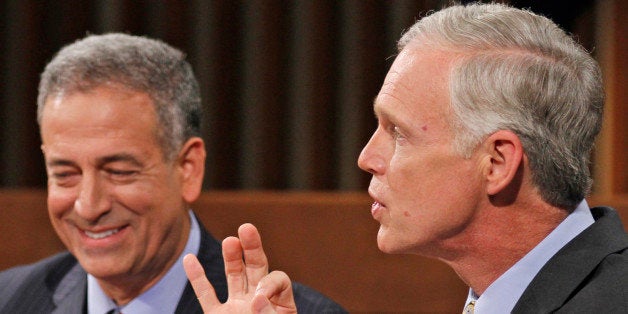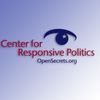
By Emma Baccellieri
Sen. Ron Johnson (R-Wisc.) and his challenger Russ Feingold have raised almost exactly the same amount of money in their race for a Wisconsin Senate seat. But they've done so in very different ways.
In terms of fundraising, the race is among the tightest in the country, not to mention one of the few where a challenger has raised more money than an incumbent. The pair is currently separated by less than a million dollars, with the Democrat Feingold and his $15.6 million narrowly ahead of the Tea Party-backed Republican Johnson and his $14.8 million.
Getting to this point, however, has taken each candidate on a very different path -- with Feingold depending on small donors, more so than almost every other Senate candidate in the country, while Johnson draws far more support from PACs and outside funding groups.
Sound like déjà vu from the 2010 election? It should. At a glance, the current situation mirrors the one from six years ago almost exactly. Then, however, Feingold was the incumbent, finishing his third term in the Senate, and Johnson was the outside challenger, a manufacturing CEO running for office for the first time. Though Feingold ultimately raised more money, with $20.8 million to Johnson's $15.2 million, Johnson narrowly won the seat. Now, with their roles reversed, the two are neck-and-neck in terms of fundraising as Feingold attempts to win back his old territory.
Just as was the case in 2010, small donors are an important component of Feingold's fundraising. More than 40 percent of his funding, or $6.3 million, has come from contributions of $200 or less -- putting him at the top of the small donor leaderboard, behind just one other Senate candidate, Alan Grayson (D-Fla.), who has raised more than 55 percent of his cash from small contributions.
Feingold is outpacing even the sizable portion he drew from the small donors in 2010, when they provided 36 percent of his cash. Johnson, on the other hand, has raised comparatively little from small donors -- 16 percent of his overall fundraising, or $2.3 million.
While Feingold's 2016 fundraising resembles his 2010 effort, Johnson has introduced an entirely new strategy. The senator's 2010 campaign was largely self-financed, with the erstwhile corporate executive providing well over half of his own campaign cash. He poured $8.7 million into the race, or enough to make up 57 percent of his total funding. (It's worth noting, though, that Johnson didn't bear that dent in his financial portfolio for too long -- shortly after winning the election, he received $10 million in "deferred compensation" from his company, the plastics firm Pacur, in a move that frustrated many Wisconsin Democrats.)
This year, however, self-financing is nearly absent from Johnson's campaign, as he's contributed just $100,000. Feingold, for his part, has not self-financed at all.
So how's Johnson making up the difference here? Several ways. For one, the broad finance, insurance and real estate sector has been far more generous than it was when he was running as a challenger, providing him $1.9 million so far this cycle, compared to $700,000 in 2010.
More notable, however, is the presence of PACs. In 2010, Johnson received only a small fraction of his funding from political action committees, a little more than $800,000 that made up just 5 percent of his overall cash. This cycle, he's received nearly $2.2 million in PAC money, or 15 percent of his funding in total, with most of that coming from PACs aligned with business organizations. PACs, particularly on the business side, tend to prefer incumbents.
Feingold, meanwhile, has received about $800,000 from PACs, many of them labor-oriented, which is slightly less than what he received from this category in 2010.
And the 2016 race has one more feature the 2010 one lacked -- the Koch brothers. The duo, well known for bankrolling a slew of conservative candidates via outside spending groups, have put more than $2.2 million into the Wisconsin race through their super PAC Freedom Partners Action Fund.
Most of that cash has been used to attack FeingoldFeingold. And it's not the only super PAC that's doing so. In total, $3.6 million from outside groups has been directed towards opposing Feingold, while another $700,000 of outside spending has gone towards supporting Johnson.
Far less outside spending -- which includes both super PACs and dark money groups, such as political nonprofits -- has been used to benefit Feingold. A little more than $500,000 has been used to oppose Johnson, while just $40,000 has gone towards supporting Feingold himself. The result is an outside spending landscape markedly different from what the race offered in 2010, when more of this cash was directed towards supporting the candidates, rather than opposing them.
Outside spending in 2010 yielded more than $1 million in pro-Feingold money and nearly $1.8 million pro-Johnson, with almost $800,000 spent against Feingold and nearly $300,000 against Johnson -- in other words, nothing approaching the $3.6 million that's fueled anti-Feingold advertisements yet this cycle.
And, as is often the case these days, it is hard to capture exactly how much has been spent by dark money groups -- nonprofit social welfare organizations that can engage in politics without disclosing their donors. For example, Americans for Prosperity, the flagship group of the Koch donor network, has reported spending only $68,812 on anti-Feingold ads, though it has spent more than $1 million on pro-Johnson ads as well.
Senior nonprofits researcher Robert Maguire contributed to this post.
